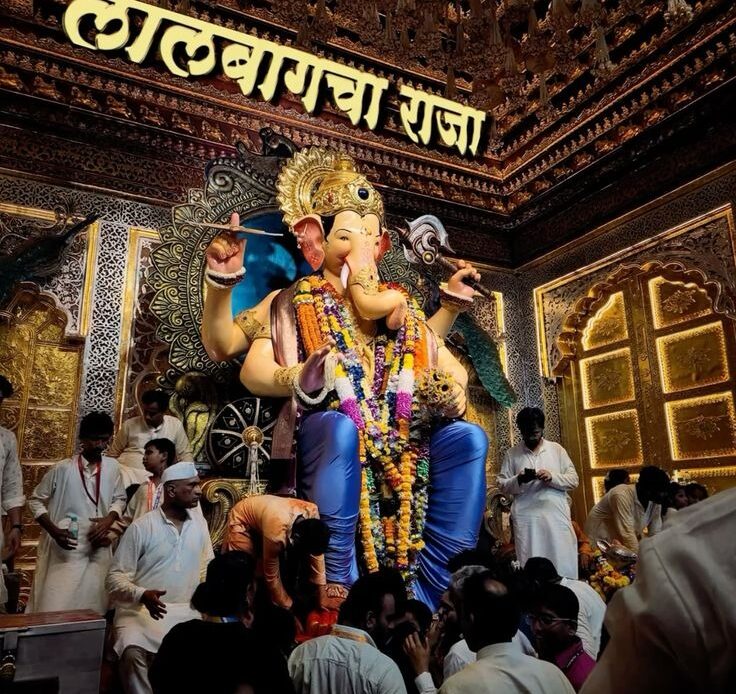Lalbaugcha Raja: Mumbai’s Beloved Wish-Fulfilling Deity
ADV. Shivam Bibhishan Bhosale
Introduction
Lalbaugcha Raja is not just a Ganesha idol; it is an emotion, a tradition, and a cultural cornerstone of Mumbai. Known as the “Navsacha Ganpati” (the wish-fulfilling Ganesha), this iconic idol has captured the devotion of millions since its inception in 1934. Established by the Lalbaugcha Raja Sarvajanik Ganeshotsav Mandal, the idol holds immense spiritual and cultural significance, drawing crowds from across the globe every year during the Ganesh Chaturthi festival.
The roots of Lalbaugcha Raja lie in faith and resilience. It originated from a vow made by local fishermen and vendors who prayed to Lord Ganesha for a permanent marketplace after their existing one was shut down. In gratitude, they established the idol, which has since become a symbol of hope, devotion, and collective faith.
Historical Background
The origins of Lalbaugcha Raja date back to 1934, during a turbulent period when the Peru Chawl market was closed down in 1932, leaving local Koli community fishermen and vendors without a stable source of livelihood. In response, they made a “navas” (vow) to Lord Ganesha, seeking a permanent location for their market.
With the support of individuals like Kuwarji Jethabhai Shah, Shyamrao Vishnu Bodhe, V. B. Korgaonkar, and others, along with local residents and the landowner Rajabai Tayyabali, a plot was secured, and the Lalbaug Market was established. On 12th September 1934, the first idol of Lalbaugcha Raja was installed in heartfelt gratitude.
The idol was adorned in traditional fishermen’s attire, paying homage to its creators. Over time, devotees began to believe that the idol could fulfill their wishes, hence the title “Navsacha Ganpati”. The formation of the Mandal coincided with India’s freedom struggle, giving it not just religious importance but also a sense of national pride and unity.
Why Millions Flock to Lalbaugcha Raja Every Year
During Ganesh Chaturthi, the Lalbaugcha Raja Mandal witnesses an unparalleled influx of devotees, all drawn by unwavering faith in the idol’s divine powers. People from all walks of life, including celebrities, politicians, and industrialists, join the queues — some waiting for up to 20 hours — just to touch the feet of the idol and offer prayers.
Lalbaugcha Raja’s appeal lies in its reputation as a wish-fulfilling deity. Devotees believe that a prayer offered here with genuine faith will not go unanswered. The event also brings with it vibrant cultural programs, music, and community service initiatives that transform it into more than just a religious event it becomes a city-wide celebration of spirit and unity.
Adding to the spectacle is the star power. Over the years, Bollywood celebrities have visited the pandal, drawing even larger crowds and generating significant media buzz. Their visits, often shared on social media, have helped elevate the idol’s stature, attracting not only spiritual seekers but also curious onlookers.
Challenges in Managing Devotee Crowds
With fame comes complexity. The Lalbaugcha Raja Mandal faces massive logistical and administrative challenges, particularly in handling the overwhelming crowds that surge into the pandal during the 10-day festival.
In recent years, serious concerns have been raised about devotee welfare, human rights violations, and mismanagement. Videos of devotees, including pregnant women, children, and senior citizens being manhandled by overzealous volunteers have gone viral on social media, sparking public outrage.
On 3rd September 2025, The Times of India reported that the Maharashtra Human Rights Commission (MHRC) had issued a notice to the Lalbaugcha Raja Ganapati Mandal, along with the Chief Secretary of Maharashtra, BMC Chief, and the Mumbai Police Commissioner, over complaints related to VIP Darshan discrimination.
The complaint, filed by Ashish Rai and Pankajkumar Mishra, alleged that the Mandal’s volunteers engaged in “malicious behaviour” toward ordinary devotees, violating their fundamental human rights. It also criticized the state administration and police for failing to take action despite repeated complaints.
The Mumbai Police Commissioner, in response, acknowledged that managing such large crowds is an ongoing issue, but also noted that incidents of fainting, manhandling, and torn clothing caused by untrained volunteers are unacceptable. Critics are urging that trained security personnel replace the existing team to ensure a respectful and safe experience for all devotees.
Conclusion
Lalbaugcha Raja is more than just a deity — it’s a living legacy of faith, culture, and community. While its spiritual aura continues to attract millions, the challenges of managing such massive gatherings must be addressed with sensitivity and responsibility.
If Lalbaugcha Raja is to continue as a symbol of hope and unity, then safeguarding the dignity and rights of every devotee must become a top priority — balancing tradition with accountability.
References:
- The Times of India (03 September 2025): MHRC issues notice to Lalbaugcha Raja Ganapati Mandal over VIP Darshan complaints.


